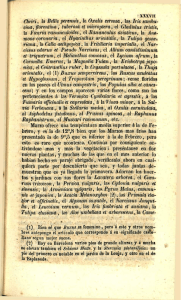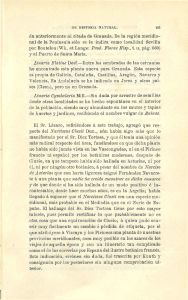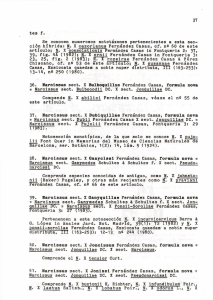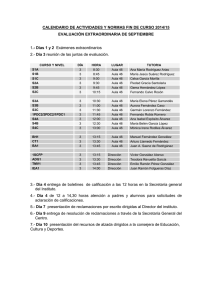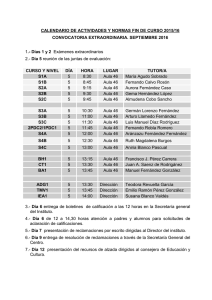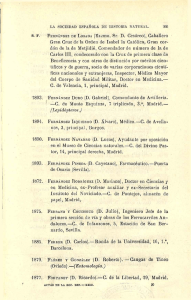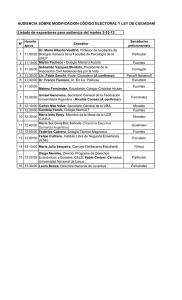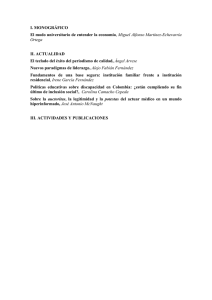View Book - Biblioteca digital del Real Jardín Botánico de Madrid
Anuncio
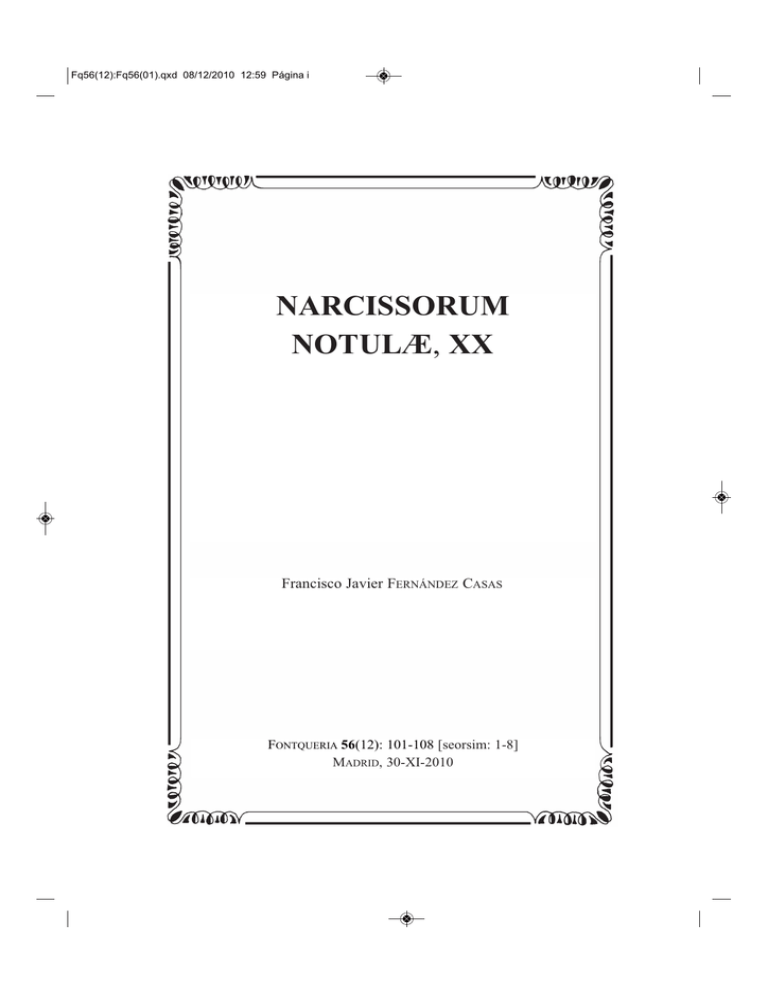
Fq56(12):Fq56(01).qxd 08/12/2010 12:59 Página i NARCISSORUM NOTULÆ, XX Francisco Javier FERNÁNDEZ CASAS FONTQUERIA 56(12): 101-108 [seorsim: 1-8] MADRID, 30-XI-2010 Fq56(12):Fq56(01).qxd 08/12/2010 12:59 Página ii FONTQUERIA is a series of botanical publications without administrative affiliation. It publishes original works in Botany, particularly those that are of interest to the editors. Its publications are in any language, the only limitation being the ability of the editorial team. Accredited with the International Association for Plant Taxonomy for the purpose of registration of new non-fungal plant names. PRODUCTION Database consultant: Typesetting: Screen operators: Preprinting: Guillermo GONZÁLEZ GARCÍA (†, 17-XI-2010) Ambrosio VALTAJEROS POBAR, Ulpiano SOUTO MANDELOS Samuel FARENA SUBENULLS, Emilio NESTARES SANTAINÉS Sonja MALDÍ RESTREPO, Demetrio ONCALA VILLARRASO DISTRIBUTION Postal distribution: Contact the editor Mail for electronic distribution: [email protected] EDITOR Francisco Javier FERNÁNDEZ CASAS. Madrid (MA) JOINT EDITOR (German text) Ramón MORALES VALVERDE. Madrid (MA) EDITING CONSULTANTS for this fascicle Josep Maria MONTSERRAT i MARTÍ (BC) María Eugenia RON ÁLVAREZ (MACB) ISSN: 0212-0623 Depósito legal: M-29282-1982 Fq56(12):Fq56(01).qxd 08/12/2010 12:59 Página 101 NARCISSORUM NOTULÆ, XX Francisco Javier FERNÁNDEZ CASAS Real Jardín Botánico, CSIC. Plaza de Murillo, 2. E-28014 Madrid (España) FERNÁNDEZ CASAS, F. J. (30-xi-2010). Narcissorum notulæ, XX. Fontqueria 56(12): 101-108 [seorsim: 1-8]. Keywords. Systematics, Nomenclature; New Hybrid Section Name; New Nothomorph; Narcissus Linnaeus (Amaryllidaceæ). Morocco, Portugal, Spain. Abstract. Notes on systematics and nomenclature about the genus Narcissus Linnaeus (Amaryllidaceæ). A new name substitute the invalid previous one: nothosect. Angusxireon replaces nothosect. Alentejani. A hybrid variety Narcissus ×alentejanus nothovar. Knochei is described as new from Portugal (Portalegre: Elvas). Résumé. Notes sur la systematique et nomenclature du genre Narcissus Linnaeus (Amaryllidaceæ). Un nouveaux nom il substitue un autre antérieur invalide: nothosect. Angusxireon remplace nothosect. Alentejani. Une variété hybride, Narcissus ×alentejanus nothovar. Knochei est décrit comme nouvelle, de Portugal (Portalegre: Elvas). Zusammenfassung. Systematische und nomenklatorische Aufzeichnungen über die Gattung Narcissus Linnaeus (Amaryllidaceæ). Ein neuer Name nothosect. Angusxireon ersetzt den vorherigen ungültig nothosect. Alentejani. Eine hybride Varietät von Portugal (Portalegre: Elvas), Narcissus ×alentejanus nothovar. Knochei wird als neu beschrieben. Resumo. Notas sistemáticas e nomenclaturais sobre o gênero Narcissus Linnaeus (Amaryllidaceæ). Propom-se um nome novo de seção híbrida para substituir outro inválido prévio: nothosect. Angusxireon substitui nothosect. Alentejani. Também é descrita uma variedade nova híbrida, Narcissus ×alentejanus nothovar. Knochei, de Portugal (Portalegre: Elvas). Resumen. Notas sistemáticas y nomenclaturales acerca del género Narcissus Linnaeus (Amaryllidaceæ). Se propone un nombre nuevo para reemplazar otro previo inválido: nothosect. Angusxireon substituye a nothosect. Alentejani. Se describe también una nueva variedad híbrida, Narcissus ×alentejanus nothovar. Knochei, de Portugal (Portalegre: Elvas). Prosigue nuestra serie de aportaciones, orientadas a lograr un mayor conocimiento del género Narcissus Linnaeus (Amaryllidaceæ); véase el artículo precedente homónimo, el cual apareció en esta misma revista, F. J. FERNÁNDEZ CASAS (2010). Bueno, si no contribuimos al mejor conocimiento del género, intentamos al menos mejorar su descripción, que no es poco. Sect. ×Seroangustifolii Fernández Casas (1997) Narcissus nothosect. Seroangustifolii Fernández Casas, Anales Jard. Bot. Madrid 54(1): 174, col. 1 (1997) – Narcissus sect. Angustifolii (A. Fernandes) Fernández Casas (1997) × sect. Serotini Parlatore (1858) TYPUS: Narcissus ×perangustus Fernández Casas, Fontqueria 55(69): 572 (22-xi-2008) [=] Narcissus nothosect. Perangusti Fernández Casas, Fontqueria 55(69): 571-572 (22-xi2008), nom. inval. “name does not comply with Art. H.7.1”, fide Index kewensis “TYPUS”: Narcissus ×perangustus Fernández Casas, Fontqueria 55(69): 572 (22-xi-2008) Propusimos la sección ×Perangusti Fernández Casas (22-xi-2008) –sect. Angustifolii (A. Fernandes) Fernández Casas (1997) × sect. Serotini Parlatore (1858)– para contener Narcissus ×perangustus Fernández Casas (2008) –N. obsoletus (Haworth) Steudel Fq56(12):Fq56(01).qxd 08/12/2010 12:59 Página 102 102 FONTQUERIA 56(12) [30-xi-2010] (1841) × N. serotinus Loefling ex Linnaeus (1753)– pero, de acuerdo con los compiladores del Index kewensis, resulta inválido porque conculca el artículo H.7.1 del Código Internacional de Nomenclatura Botánica. La fórmula ×Seroangustifolii Fernández Casas (1997) –sect. Serotini Parlatore (1858) × sect. Angustifolii (A. Fernandes) Fernández Casas (1997)– se propuso señalando Narcissus ×obsoletus (Haworth) Spach (1841) como taxo único. Es evidente que entonces interpretábamos tal especie de modo diferente a como ahora lo hacemos, ya que hoy no la entendemos como mesto sino como especie generatriz, cf. F. J. FERNÁNDEZ CASAS & J. M. PIZARRO DOMÍNGUEZ (2007). Hay pero otras interpretaciones, como vemos en Z. DÍAZ LIFANTE & C. ANDRÉS CAMACHO (2007), o en Z. DÍAZ LIFANTE, C. ANDRÉS CAMACHO, J. VIRUEL & A. CABRERA CABALLERO (2009). Supongo que, al tratarse de una fórmula, el tipo poco importa, o ni siquiera lo tiene. Tanto si se acepta nuestro criterio actual sobre la identidad de Narcissus obsoletus –F. J. FERNÁNDEZ CASAS (2008)–, como si se prefiere seguir el de la competencia hispalense, el mesto al que nos referimos mantiene el nombre que aquí empleamos. Sect. ×Angusxireon Fernández Casas (2010) Narcissus nothosect. Angusxireon Fernández Casas, nom. nov., Fontqueria 56(12): 102 (30-xi-2010) [≡] Narcissus nothosect. Alentejani Fernández Casas, Fontqueria 55(67): 555 (15-xi-2008), nom. inval. “name does not comply with Art. H.7.1”, fide Index kewensis – Narcissus sect. Angustini Fernández Casas (2008) × sect. Braxireon (Rafinesque) B. Valdés (1984) TYPUS: Narcissus × alentejanus Fernández Casas, Fontqueria 55(67): 555-556 (15-xi-2008) Propusimos la sección ×Alentejani Fernández Casas (15-vi-2008) –sect. Angustini Fernández Casas (2008) × sect. Braxireon (Rafinesque) B. Valdés (1984)– para contener Narcissus ×alentejanus Fernández Casas (2008) –N. Cavanillesii Barra Lázaro & López González (1984) × N. serotinus Loefling ex Linnaeus (1753)– pero, de acuerdo con los compiladores del Index kewensis, resulta inválido porque conculca el artículo H.7.1 del Código Internacional de Nomenclatura Botánica. 01 Narcissus ×alentejanus Fernández Casas, Fontqueria 55(67): 555-556 (15xi-2008), nothovar. × alentejanus INDICATIO LOCOTYPICA: Portugal, Portalegre, 29SPC59, «Elvas: prope eremitorium Nosa Senhora da Ajuda dictum, iuxta flumen Guadiana, ad 180 m. In pascuis nunc siccis, apricis, petrosis» TYPUS: F. J. Fernández Casas Ff-047-08 & U. E. Souto Mandelos, 14-x-2008 (MAF s/n, holo-) – Narcissus Cavanillesii Barra Lázaro & López González (1984), [fœmineus] × N. serotinus Loefling ex Linnaeus (1753), [masculus] ≠ Narcissus ×Perezlaræ Font Quer, Bol. Real Soc. Esp. Hist. Nat. 27: 44 (1927), pro hybr., non Narcissus Perezlaræ Traub, Plant Life 24: 49 (1968), "Perezlaraii", quod est Narcissus Cavanillesii Barra Lázaro & López González (1984) × N. deficiens Herbert (1847) DISTR. GEOGR.: Hispania (Badajoz), Lusitania (Alto Alentejo). BIBLIOGR.: I. C.MARQUES, A. ROSSELLÓ-GRAELL & D. DRAPER MUNT (2005); I. C. MARQUES, A. ROSSELLÓ-GRAELL, D. DRAPER MUNT & J. M. IRIONDO ALEGRÍA (2007). I. C. MARQUES, G. NIETO FELINER, D. DRAPER MUNT, M. A. MARTINS-LOUÇÃO & F. J. FUERTES AGUILAR (2010). ILLUSTR. (photo): I. C. MARQUES, A. ROSSELLÓ-GRAELL & D. DRAPER MUNT (2005: tab. 1, fig. c, d; pag. 214). F. J. FERNÁNDEZ CASAS (2008: lam. i, figæ. a-d, pag. 551; lam. iv, figæ. a, b, Fq56(12):Fq56(01).qxd 08/12/2010 12:59 Página 103 F. J. FERNÁNDEZ CASAS – Narcissorum notulæ, XX a 103 b c LÁMINA I. Narcissus ×alentejani Fernández Casas nvar. Knochei Fernández Casas. Portugal, Portalegre: Elvas, F. J. Fernández Casas Ff_2010-100, 15-x-2010 (recolección tipo). Fq56(12):Fq56(01).qxd 08/12/2010 12:59 Página 104 104 FONTQUERIA 56(12) [30-xi-2010] a b c d e LÁMINA II. Narcissus ×alentejani Fernández Casas nvar. alentejanus Fernández Casas. Portugal, Portalegre: Elvas, F. J. Fernández Casas Ff_2010-090, 15-x-2010 (topótipo). Fq56(12):Fq56(01).qxd 08/12/2010 12:59 Página 105 F. J. FERNÁNDEZ CASAS – Narcissorum notulæ, XX 105 a a LÁMINA III. Narcissus ×alentejani Fernández Casas nvar. Knochei Fernández Casas. Portugal, Portalegre: Elvas, F. J. Fernández Casas Ff_2010-100, 15-x-2010 (recolección tipo). Fq56(12):Fq56(01).qxd 08/12/2010 12:59 Página 106 106 FONTQUERIA 56(12) [30-xi-2010] a e d c b LÁMINA IV. Narcissus ×alentejani Fernández Casas nvar. Knochei Fernández Casas. Portugal, Portalegre: Elvas, F. J. Fernández Casas Ff_2010-100, 15-x-2010 (recolección tipo). Fq56(12):Fq56(01).qxd 08/12/2010 12:59 Página 107 F. J. FERNÁNDEZ CASAS – Narcissorum notulæ, XX 107 pag. 554). Lamina nostra ii, pag. 104. CARYOLOGIA: 2n= 19 (5 + 14), I. C. MARQUES, G. NIETO FELINER, D. DRAPER MUNT, M. A. MARTINS-LOUÇÃO & F. J. FUERTES AGUILAR (2010). 02 Narcissus ×alentejanus Fernández Casas nothovar. Knochei Fernández Casas, nothovar. nov., Fontqueria 56(12): 107-108, nº 2 (30-xi-2010) TYPUS: F. J. Fernández Casas Ff_10-100 (MAF s/n, holo-) Narcissus Cavanillesii Barra Lázaro & López González (1984), [masculus] × N. serotinus Loefling ex Linnaeus (1753), [fœmineus] ?= Narcissus ×moronensis K. G. Knoche, Herbertia 62: 48s (2009) ut Narcissus Cavanillesii Barra Lázaro & López González (1984) × N. serotinus Loefling ex Linnaeus (1753) INDICATIO LOCOTYPICA: «Spain. Sevilla province: Sierra de Esparteros (Sierra de Morón), 300 m, 37º04'46.01"N, 5º30'52.50"W, with both parents on lower part of the Sierra, dry rocky hillside near road A 361. Morón de la Frontera to Montellano, between km 24 and 25» TYPUS: K. G. Knoche 1004, 01-X-2007 (OSBU, holo-) ILLUSTR. (photo): Laminæ nostræ i, pag. 103; iii, pag. 105; iv. pag. 106. DISTR. GEOGR.: Hispania (Sevilla)?, Lusitania (Alto Alentejo). CARYOLOGIA: 2n= 19 (5 + 14), K. G. KNOCHE (2009: 48, 53). – DESCRIPTIO ex holotypo A varietate typica –nvar. alentejanus– tubo florali cylindrico turbinato longiore atque strictiore valde dissimilis. Floralium colore mutabile neque homogeneo; floribus adulescentibus iunioribusque luteo cremeis, adultis ex luteo irregulariter albo variegatis. OBSERVACIONES Pese a ser simpátrida con la variedad típica –en grado extremo, su tipo se colectó a muy pocos metros del topótipo de la notovariedad ×alentejanus–, las diferencias morfológicas son notables; tal circunstancia –grandes diferencias– no es infrecuente entre notomorfos. Al verla por primera vez, incluso desde cierta distancia, se aprecian las diferencias de forma y color, incluso sin agacharse; también es más alta y erecta; véanse las fotografías en las láminas i, iii y iv, y compárense con las de la lámina ii, que corresponden al tipo de ×alentejanus. La interpretación que hacemos arriba según la cual sería Narcissus serotinus el parental que aporta el gámeta femenino y el rudimento seminal es una mera suposición que estimo acertada, pero que no tiene otro fundamento que sus afinidades morfológicas, apreciadas a simple vista. El nuevo mesto tiene un enorme parecido con Narcissus ×moronensis, tal como lo describe e ilustra K. G. KNOCHE (2009). Quizás se trata de un mismo taxo, pero no me atrevo a afirmarlo de una vez. He dejado la sinonimia con interrogación, de modo que no se establezca igualdad homotípica, para mantener la puerta abierta a una posible ulterior interpretación diferente. Por supuesto que me hubiera gustado manterner el epíteto “moronensis” y el nombre de mi colega. Narcissus ×moronensis, la planta híbrida que describe Karl Gerd KNOCHE, tiene más afinidad morfológica con N. serotinus que mi N. ×alentejanus, y que el notomorfo ahora propuesto. Por más que el mesto de Knoche está bien descrito (página 48 y siguientes), bien comparado (tabla 1; página 58), bien fotografiado (figs. 4, 5, 6, y 7; páginas 49-51), y bien dibujado (fig. 8; página 51), yo no he estudiado su tipo (K. G. Knoche 1004; OSBU), ni tampoco pude encontrarlo sobre el terreno –esto sí ha sido decisivo para tomar mi decisión–, en mis dos visitas recientes a la localidad clásica. Visité la Sierra de Morón en dos ocasiones; el 16-x-2010 encontré Narcissus Cavanillesii en plena floración y con fructificación iniciada; abundantísimo tanto en la base oriental de la sierra como por toda su ladera media, entre hierbas y matorrales, o Fq56(12):Fq56(01).qxd 08/12/2010 12:59 Página 108 108 FONTQUERIA 56(12) [30-xi-2010] como casmófito con Ranunculus bullatus; Narcissus serotinus era más escaso, apenas unos rodales en pequeñas depresiones con otras herbáceas, en la base de la sierra. En mi segunda visita, el 05-XI-2010, la primera especie era menos conspicua, apenas quedaban flores y los frutos más avanzados comenzaban a asperger sus semillas negras. N. serotinus en cambio había tomado el relevo, especialmente en la base de la sierra, donde abundaba en flor y con abundantes frutos, desde verdes hasta casi maduros. Pese a lo abundatísimos que eran ambas especies progenitoras, no pude dar con el mesto que describiera K. G. Knoche. La situación fue frustante, pocas veces en mi vida he encontrado poblaciones de dos especies de narcisos, tan abundantes y tan bien mezcladas, que no me permitiesen ver sus mestos. Por lo que hace a la morfología externa, desde Narcissus Cavanillesii hasta N. serotinus conocemos hasta hoy una progresión formada por tres pasos. N. ×alentejanus es el más próximo de N. Cavanillesii. N. ×moronensis es el más próximo de N. serotinus. N. ×Knochei parece intermedio entre ambos mestos, aunque más próximo del segundo. Narcissus ×moronensis se parece mucho a N. ×Perezlaræ, aunque el tamaño de todas sus partes parece menor; véase la cuidadosa descripción de B. VALDÉS CASTRILLÓN, D. MÜLLER-DOBLIES & U. MÜLLER-DOBLIES (1984). ORIGEN DEL NOMBRE y su prosodia El restrictivo varietal honra a nuestro colega Karl Gerd KNOCHE, quien descubrió y describió Narcissus ×moronensis K. G. Knoche (2009). Es voz llana, acentuada prosódicamente en la primera (penúltima) sílaba: knó-chei. Las dos últimas vocales forman diptongo y se pronuncian con un golpe de voz único. PORTUGAL, (16) PORTALEGRE: 29SPC59 38.80º, -007.22º; «Elvas: prope eremitorium Nosa Senhora da Ajuda dictum, iuxta flumen Guadiana, ad 180 m. In pascuis nunc siccis, apricis, petrosis», F. J. Fernández Casas Ff_10-100, 15-x-2010 (MAF s/n, holo-; typus N. ×alentejanus nvar. Knochei). REFERENCIAS BIBLIOGRÁFICAS DÍAZ LIFANTE, Z. & C. ANDRÉS CAMACHO (2007). Morphological variation of Narcissus serotinus L. s. l. (Amaryllidaceæ) in the Iberian Peninsula. Bot. J. Linn. Soc. 154(2): 237-257. DÍAZ LIFANTE, Z., C. ANDRÉS CAMACHO, J. VIRUEL & A. CABRERA CABALLERO (13-iii-2009). The allopolyploid origin of Narcissus obsoletus (Alliaceæ); and identification of parental genomes by karyotype characterization and genomic in situ hybridization. Bot. J. Linn. Soc. 159(3): 477-498. FERNÁNDEZ CASAS, F. J. (22-xi-2008). Narcissorum notulæ, XI. Fontqueria 55(69): 571-572 [seorsim 1-2]. FERNÁNDEZ CASAS, F. J. (26-viii-2010). Narcissorum notulæ, XIX. Fontqueria 56(10): 75-80 [seorsim: 1-6]. FERNÁNDEZ CASAS, F. J. & J. M. PIZARRO DOMÍNGUEZ (07-iv-2007). Acerca de Narcissus obsoletus (Haworth) Steudel (Amaryllidaceæ). Adumbr. Summæ Ed. 24: 1-22. KNOCHE, K. G. (2009). Narcissus ×Moronensis Knoche (Amaryllidaceæ), a new autum flowering Narcissus hybrid from Southern Spain. Herbertia 62: 45-58. MARQUES, I. C., G. NIETO FELINER, D. DRAPER MUNT, M. A. MARTINS-LOUÇÃO & F. J. FUERTES AGUILAR (viii-2010). Unraveling cryptic reticulate relationships and the origin of orphan hybrid disjunct populations in Narcissus. Evolution 64(8): 2353-2368. Epub 2010 Feb 26 MARQUES, I. C., A. ROSSELLÓ-GRAELL & D. DRAPER MUNT (2005). Narcissus ×Perezlaræ (Amaryllidaceæ) new for the Portuguese flora. Fl. Medit. 15: 211-217. MARQUES, I. C., A. ROSSELLÓ-GRAELL, D. DRAPER MUNT & J. M. IRIONDO ALEGRÍA (2007). Pollination ecology and hybridization between Narcissus Cavanillesii A. Barra & G. López and N. serotinus L. in Portugal. Bocconea 21: 65-75. VALDÉS CASTRILLÓN, B., D. MÜLLER-DOBLIES & U. MÜLLER-DOBLIES (1984). Narcissus ×Perezlaræ Font Quer. Morfología, cariología y tipificación. In B. VALDÉS CASTRILLÓN (ed.) Notas taxonómicas y corológicas sobre la flora de Andalucía occidental, 101. Lagascalia 12(2): 253-260.
